In our wildest dreams, we couldn’t have imagined not only seeing a cheetah hunt, but also capturing the whole thing on film.
This post contains affiliate links for which Expedition Wildlife may receive a commission (where applicable) at no additional cost to you.
When Nathan and I first started planning our trip to Tanzania, we planned the shots we wanted to capture on film.
Anyone dreaming of or planning a safari thinks about the kinds of experiences they want to have and the animals they’ll end up seeing.
Though we’d hoped to see a cheetah hunt, we never thought we’d see one as awe-inspiring as this one.
Before we go into our experience witnessing such an incredible moment, let’s dive into some basic information about cheetahs.
A word of caution. Our footage and images show a wildebeest being taken down by two cheetahs. If you are sensitive to these materials, proceed with caution. Please understand that cheetahs also need to find a means to stay alive.
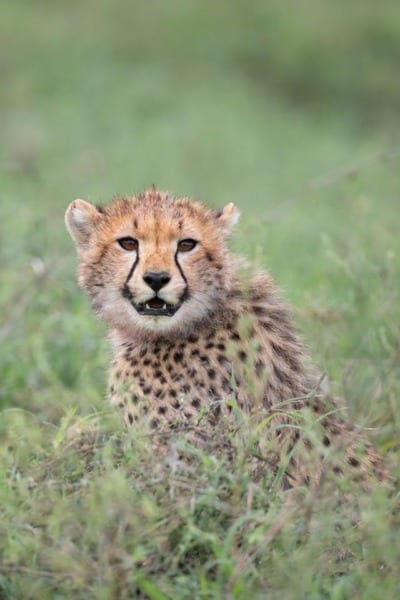
Cheetah cubs will stay back away from their mother while she hunts, camouflaging themselves into the surrounding landscape. Photo by Nathan Rolls
A Little Info about Cheetah Behavior
Where do cheetahs live?
There are four different sub-species of cheetah in the world, mostly distributed throughout Africa with one very small population in Iran.
These subspecies all look quite similar, but genetically, they are different enough to be considered scientifically distinct.
Cheetahs need quite a bit of space to live and thrive.
Good grassland and savannah habitat, enough food to eat, and limited numbers of other predators within the same area, among other things, determine how much space a cheetah needs.
Cheetahs do not live in prides, as lions do. Rather, sibling male cheetahs will form what is called a “coalition,” a small group of male cheetahs that often stay together for life.
Female cheetahs often live and wander on their own, with the exception of the time they are caring for their cubs.
READ NEXT | African Safari Checklist: What to know before you go
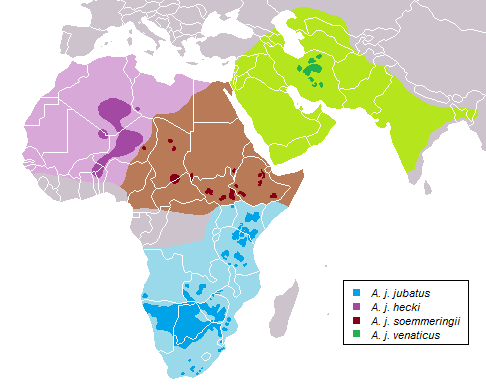
The four subspecies of the cheetah are distributed primarily around the African continent, with a small subpopulation of around 50 individuals in Iran. Image by the Species Survival Commission
What do cheetahs eat?
Cheetahs are apex predators in the regions in which they are found.
They are carnivores and thus eat meat, so their diet consists of small to medium-sized mammals, primarily antelope, gazelle, rabbit, and the young of herd animals, such as wildebeest.
However, sick, slow, or young animals are typically most likely to be captured. Genetically, for the prey, this helps to eliminate weaker individuals from the herd and allows stronger individuals to prevail.
While cheetahs may be very good at hunting down their prey, they aren’t as well-built for defending it. This provides food for other animals, especially scavengers.
The act of limiting the savannah grazing animal populations helps to maintain the larger savannah ecosystem. Without cheetahs and other predators, these ecosystems would function very differently.
How often do cheetahs need to eat?
What’s really incredible about cheetahs is that they have to make these speed-defying hunts every few days.
Even after catching a good-sized animal, such as a young wildebeest, within a few days’ time, the cheetah will be looking lean and hungry and must do it all over again.
How do cheetahs hunt?
Cheetahs are known to be the fastest land animal in the world, reaching speeds of up to 60 miles per hour in a few seconds flat. Despite this speed, it is short-lived, meaning their hunting tactics must be spot-on to ensure capturing prey.
The “stalk” is what they’re good at. They crouch and lie in wait until the prey has averted their eyes, at which time the cheetah will continue moving forward slowly.
While cheetahs are lean, to give them speed, they aren’t especially strong. When a cheetah kills its prey, it attempts to subdue its food by latching on to the throat and suffocating the animal.
Cheetahs, and other big cats, will move with their prey. The Great Migration in Eastern Africa includes tens of thousands of wildebeest, antelope, and zebra, all of which are following the food and water as the seasons change. So, too, then do the predators follow along.
These beautiful cats are also incredibly resourceful, using termite mounds and rocks to get a better vantage point of the landscape in search of prey.
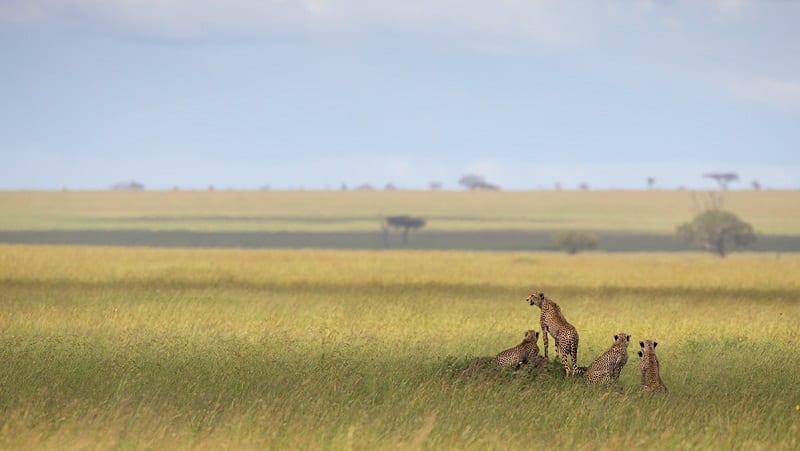
A female cheetah, accompanied by her four cubs, uses the high ground of a termite mound to search for food. Photo by Nathan Rolls
How to Increase your Chances of Seeing a Cheetah Hunt
Get an ethical guide who seeks to be a naturalist in their field
First and foremost, having a good guide will allow you to see wildlife and have those experiences you’re dreaming about.
Guide ethics is a HUGE factor here. I guarantee you will have many incredible experiences going with a guide who knows the behavior of the animals they’re watching and seeks to respect them. This is called being a naturalist.
Unknowledgeable safari guides aim for the quick, close look. This approach not only robs the visitor of better understanding the wildlife they’re seeing, but also it has the serious consequence of negatively impacting animals.
We went with The Wild Source because of their ethical guiding practices, their goal of giving opportunities to local communities, and their conservation research and initiatives.
Give the animals space and don’t get between the animal and its prey
Second, NEVER get in between an animal and its prey. This is where the concept of being a naturalist comes into play. And why having an ethical guide is important.
Giving the animals space and a clear line of sight to their prey allows for greater chances of an uninhibited and successful hunt.
When safari vehicles block animals from seeking out their prey in an effort to give their clients an up-close look at the animal of interest, it likely means an unsuccessful hunt.
Unfortunately, we’ve witnessed this in the Serengeti. Particularly during the wet season when the number of accessible places becomes limited, the chances of his happening increase.
Have patience. Seek to understand their behavior. Give the animals space.
We are compiling a full video of the cheetah hunt – in the meantime, you can watch our Tanzania video! The cheetah hunt segments begin at 3:46.
Our Cheetah Hunt Experience
We visited the Serengeti in December, during the short rain season. In this particular cheetah hunt, we were in the south Serengeti, where the grass is much shorter than that found in the north, and where the scrub is more plentiful.
Only during certain times of the year, in the short rain season, can you drive off-road in this region of the Serengeti. There are other parts of the park, including the central, one of the busiest and most popular regions, where off-roading is strictly forbidden year-round.
Also, our guide, Josh of The Wild Source, was amazing, and really cared about our experience AND the wildlife.
Following Milk and Coffee
While driving through the savannah, we spotted two Cheetah brothers, named Milk and Coffee. These males are being studied by the biologists at The Wild Source’s Njozi Camp, so Josh knew them immediately.
We followed Coffee and Milk for much of the afternoon, despite it being a hot one. The brothers would rest for a short time, then keep continuing on.
The whole time, we maintained our distance and let them wander where their inner compass led them.
Serengeti literally translates to “endless plains.” So, we were the only ones out in the savannah with them all day, seemingly alone with Coffee and Milk for as far as the eye could see.
With a slight breeze coming through the truck, it was incredibly relaxing just watching them for hours.
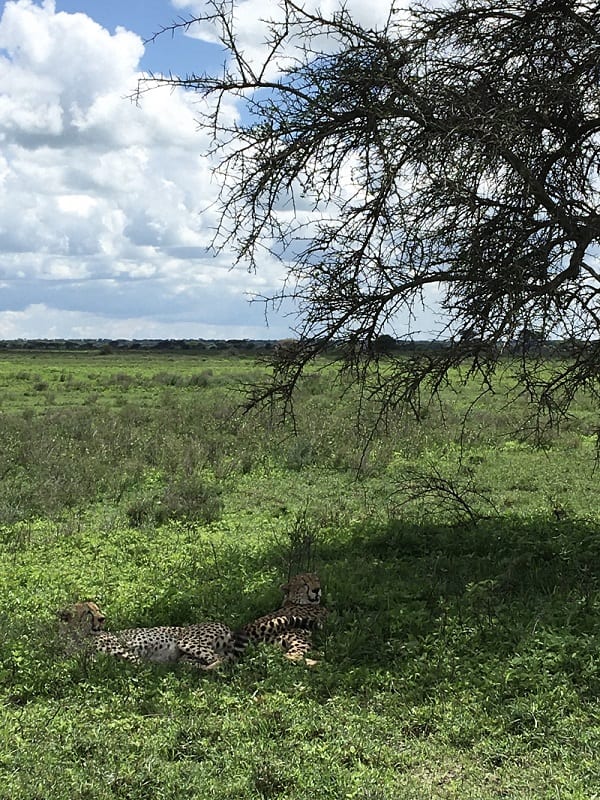
Milk and Coffee take refuge in the shade of a small acacia tree. Photo by Christa Rolls
Josh knew almost immediately that we would likely see the brothers hunt, for two reasons.
One, they looked really lean, indicating they likely hadn’t eaten a good meal in days.
Two, both Coffee and Milk would mark their territory consistently, never stopping for long, almost as if on a mission.
From all around us we couldn’t see hardly any prey, other than a couple of giraffes loping across the plains in the distance. But, cheetahs wouldn’t go for a large, healthy giraffe.
A couple of hours after watching and following the cheetahs from a distance, we were jolted out of our warm afternoon stupor when we saw a herd of wildebeest a mile off in the distance running right toward us.
We were in shock, but Josh was already on top of it and immediately said, “ok, here we go.”
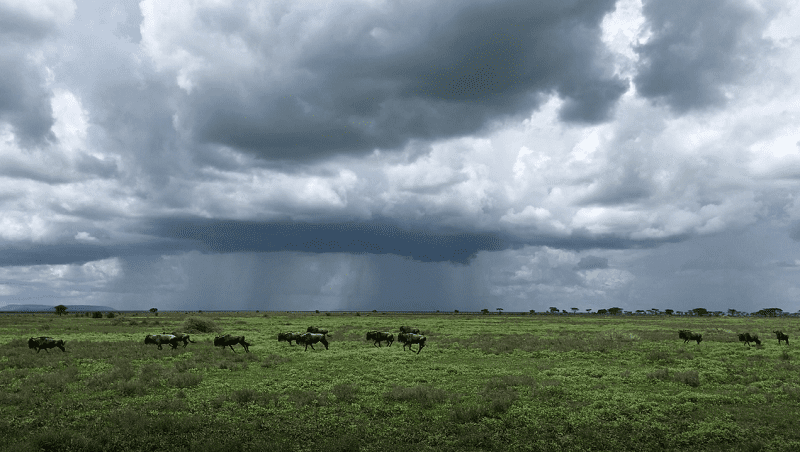
Once in place with our vehicle, this was our view – a herd of wildebeest running along the savannah. Photo by Christa Rolls
The cheetah hunt
The wildebeest were far enough away that we had time to loop away from the cheetahs so as to not disturb them as well as not deter the horde of wildebeest on their path.
Situated on the far side of the stream of wildebeest, we were just past where the cheetahs would intersect with the herd.
Josh suspected out loud that the wildebeest were just on the move, running together to the watering hole not a quarter-mile away. There were hundreds of them.
With the backdrop of the short rains stormy sky filling the air, the sight was incredible.
As soon as we were situated, one of the brothers took off, launching himself into the throng of wildebeest. The one he honed in on was a young wildebeest, smaller and more lightly colored than the rest.
Everything happened within a minute, even the young wildebeest attempting another getaway. With two strong male cheetahs, however, it wasn’t a match.
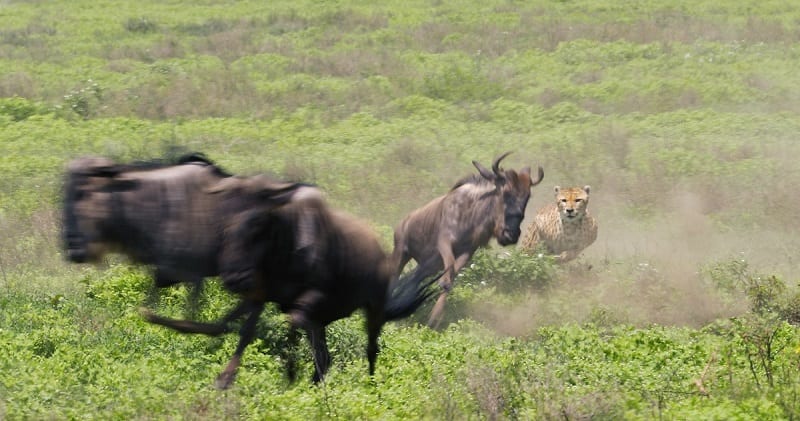
This incredible image was captured by Nathan during the hunt. Photo by Nathan Rolls
Afterthoughts
Nathan did a phenomenal job at keeping the camera on the cheetah hunt the whole time.
Of course having the pop-up top on the safari truck was essential, as was having the camera set up on a sturdy tripod in the vehicle with a smooth panning video head.
Admittedly, I did have to sit down for a minute during the final moments of the kill.
It’s never more apparent how truly wild everything is until you see it play out in nature, especially in person.
This, friends, is the circle of life.
It’s also important to note that this should not make you fear cheetahs. On safari, you will be in a safari vehicle with your (knowledgeable) guide the entire time.
Yes, they are wild and powerful animals, but this is also their nature. Frankly, they are not interested in people. The better we can understand cheetahs and their ecology, the better we can live together with them.
READ NEXT | How to Watch Wildlife Ethically
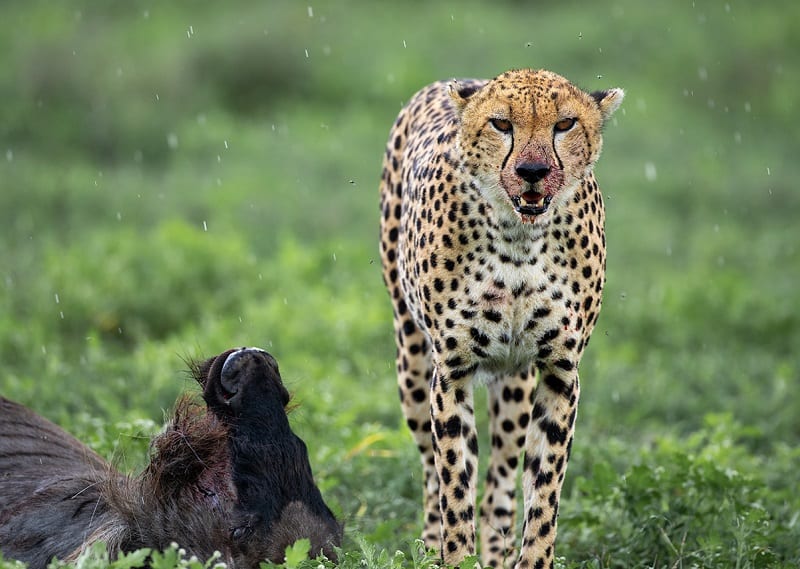
Nathan captured this stunning image after the cheetahs had taken down the wildebeest. Exhausted from the hunt, the cheetah sat with its kill nearby to catch its breath. Photo by Nathan Rolls
How Can We Help Cheetahs?
Cheetahs are considered “Vulnerable” on the IUCN Red List, with their population status declining. There are only around 7,000 cheetahs remaining in the wild.
Cheetahs are most at risk from three primary things:
- Human-wildlife conflict with ranchers and farmers, who worry for their livestock.
- Loss of the open grassland and savannah habitats on which cheetahs depend.
- The illegal trading and selling of cheetah cubs.
For more information about how you can help cheetahs, visit one of the many organizations working to ensure a future for cheetahs. Those include:
Panthera – Leading organization focusing solely on big and small cat conservation around the world.
Cheetah Conservation Fund – Renowned Nonprofit Organization focusing on cheetah conservation worldwide.
Select The Wild Source or other ethical guides – When you stay at certain research camps hosted or supported by The Wild Source, your money goes toward cheetah and other big cat conservation.
Have you seen a cheetah hunt in the wild? We’d love to hear about your experience in the comments.
Happy travels,
Christa and Nathan
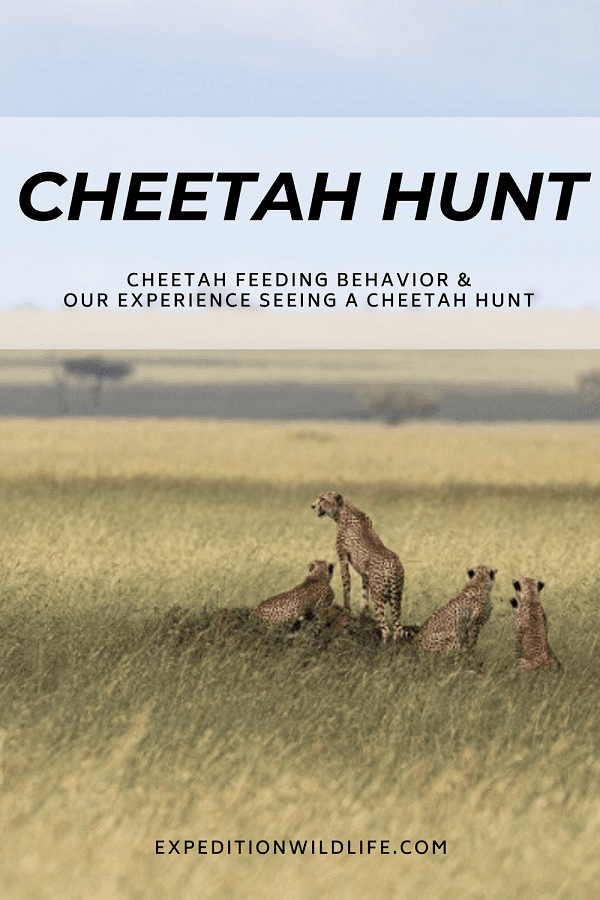

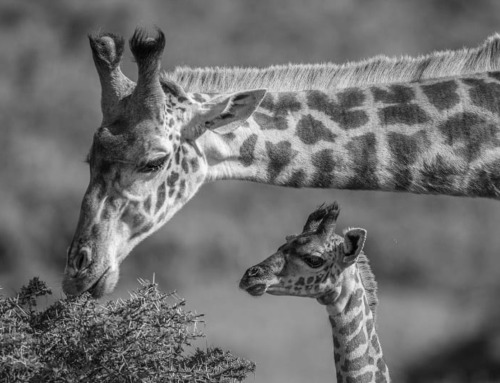
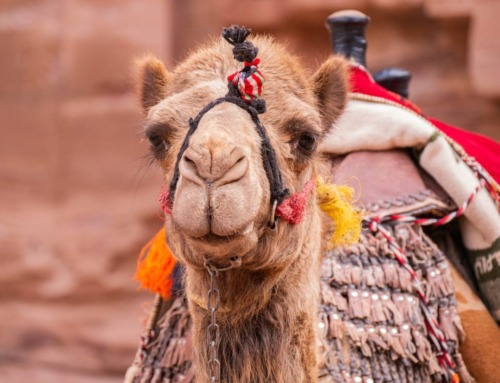
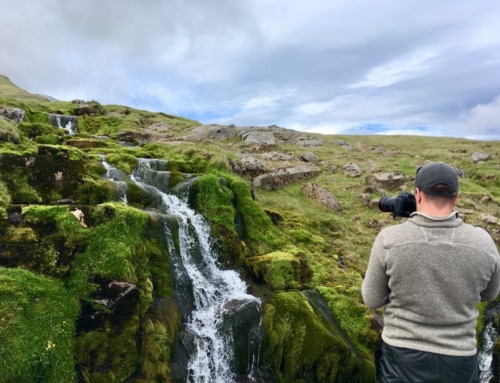
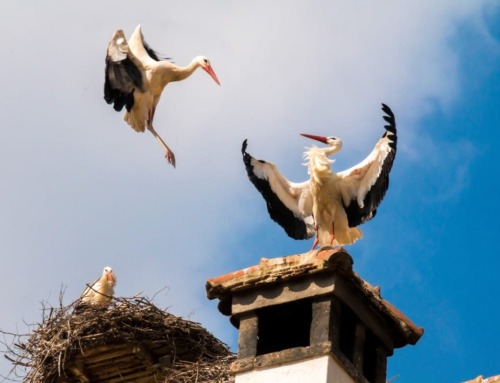
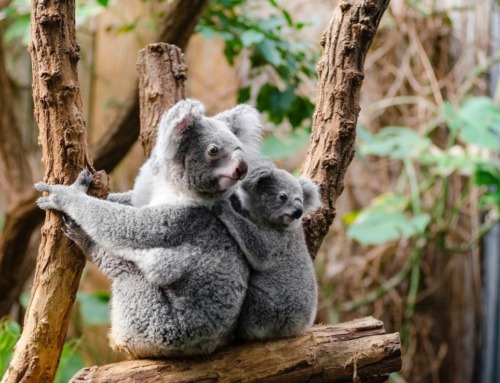
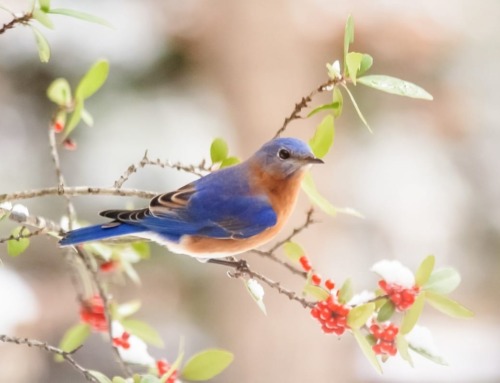
Interesting AND inspiring. Gorgeous pics, too. Thanks for the share. You raise an important point: finding the right guide. Any instructions on where / how to look for one – whether here or elsewhere (topic for a blog post? if you don’t already have one).
Karin, thanks so much! We have an upcoming blog post on this topic, but I’ll give you a couple of the points I consider when looking for guides. If the goal is to see wildlife, contacting and asking the experts on the region or animals you’re interested in seeing is a good way to ensure you’ll get a good, knowledgeable, and ethical guide. I will reach out to local research stations or national parks to inquire if they have verified guides they recommend. Also, often, guides and guide companies that are involved in the community, including contributing in some way to conservation efforts and employing locals, have a good understanding of all-around conservation needs and ethical practices. I hope this helps! I’ll elaborate on these points and discuss others in our upcoming post!